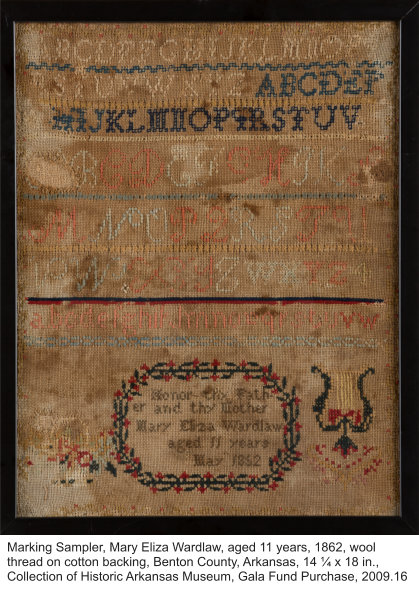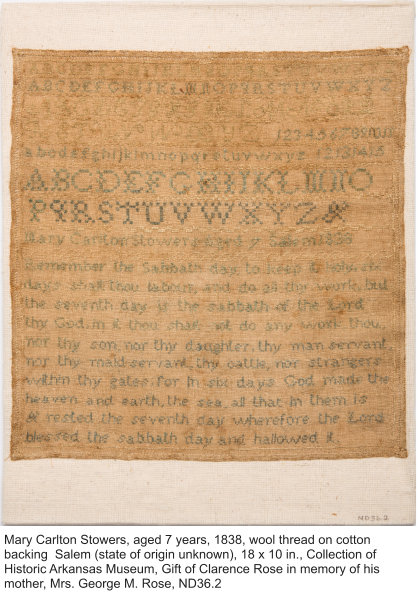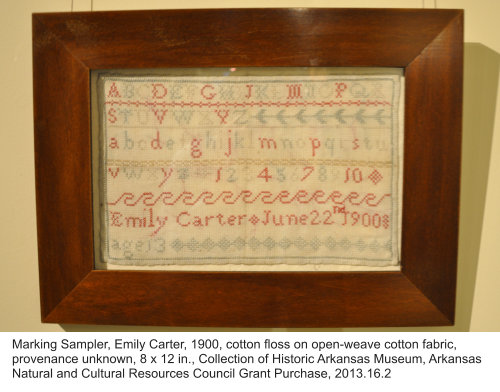.jpg?sfvrsn=f8efb265_1)
This post is part of an occasional series where the Historic Arkansas Museum shares works that didn’t make it to the “A-side” of our exhibitions or collection catalogues.
So much work goes into planning an exhibit, even the smallest ones. A building contractor once told us that the little custom jobs surprisingly take him just as much time—even more—as the large commercial projects, because of the careful thought and the many decisions that go into the meticulous work of fine tuning.
One of the hardest parts of planning our needlepoint sampler exhibit was deciding just which samplers to choose from our historic textile collection. For museum professionals who have spent their entire careers going out and collecting each and every precious acquisition, this selection process can feel as painful as having to choose a favorite child.
We had too many wonderful historic samplers to choose from. Some we liked for their whimsical, original design motifs, while others represented a widespread design trend that told a bigger story. Some works we revered for their exquisite workmanship, while others had incredible American historical significance.
Thank goodness we have a way to share with you the runners-up samplers that, for whatever reason did not quite make it to the gallery walls. Perhaps they were too fragile to show; we needed more time to research, or, in the case of a few, they were so amazing that we saved them for the limelight of a larger exhibit. We hope you enjoy a few of these equally loved, long lost “siblings” of “These Various Threads I Drew.”
Mary Eliza Wardlaw

The inscription at the bottom-center reads:
Honor thy Fath- / er and thy Mother / Mary Eliza Wardlaw / aged 11 years / May 1862.
Mary Carlton Stowers

The verse inscribed on this sampler reads:
Remember the Sabbath day to keep a holy six
Days shalt thou labour and do all thy work, but
The seventh day is the Sabbath of the Lord
Thy God, in it thou shall not do any work thou
Not thy son, nor thy daughter, they man servant,
Nor thy maid servant, thy cattle, nor strangers
Within thy gates for in six days God made the
Heaven and earth, the sea, all that in them is
& rested the seventh day wherefore the Lord
Blessed the Sabbath day and hallowed it.
Emily Carter

Emily Carter’s rather plain marking sampler is dated June 22, 1900, making it one of the youngest samplers in the museum’s collection. Executed in cross stitch using cotton floss on an open-weave cotton fabric, it represents the end of needlework samplers as tools for women’s education and literacy. The production of needlework samplers waned in the 20th and 21st centuries as a woman’s ability to execute fine needlework became less important, but samplers are experiencing a resurgence of interest as folksy decorations and nostalgic craft activities.
Emily Carter’s sampler is bound by a simple border and features an uppercase and lowercase alphabet, the numbers one through ten (instead of zero through nine on most earlier samplers), and a variety of geometric motifs used to separate the lines of cross-stitch letters. Unlike other samplers in the museum’s collection which primarily used an English cross-stitch method, Emily Carter mixed both the English and Danish methods. Emily was 13 years old when she completed this sampler. While a number of girls named Emily Carter were born around 1887 and can be found in US Census records, it is impossible to know without more specific background information which Emily Carter stitched this sampler.
"These Various Threads I Drew: Needlework Samplers" is in the Study Gallery through June 2018.
